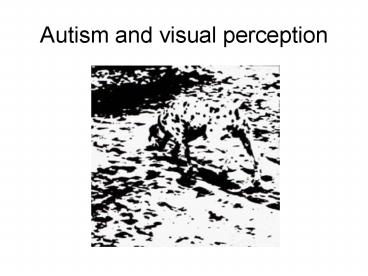Autism and visual perception - PowerPoint PPT Presentation
1 / 52
Title:
Autism and visual perception
Description:
Autism and visual perception. Structure. Weak Central Coherence Theory ... Echopraxia (Russell, 1997) involuntary imitation of observed actions. Mirror Neurones ... – PowerPoint PPT presentation
Number of Views:418
Avg rating:3.0/5.0
Title: Autism and visual perception
1
Autism and visual perception
2
Structure
- Weak Central Coherence Theory
- Global/ Gestalt/ Spatial frequency
- Audition
- Multisensory integration
- Mirror neurons
3
Weak Central Coherence Theory
- Frith (1989)
- Frith and Happé (1994)
- Happé (1999)
- Happé and Frith (2006)
- Local/global processing bias
- QJEP (2008 - 61(1))
4
Navon (1977)
5
CEFT
6
Block design task (Shah and Frith, 1993)
7
ASD drawing of a house
8
Fragmented Figures Test (Snodgrass et al., 1987)
9
Impossible figures (Booth, 2006)
10
Visual Illusions
- Happé (1996)
- Children with ASD fail to succumb to visual
illusions - Ropar and Mitchell (1999) failed to replicate
11
Titchner Circles
12
Muller-Lyer
13
(No Transcript)
14
Pogendorf Illusion
15
(No Transcript)
16
(No Transcript)
17
Happé and Booth (2008)
- Reduced global processing
- Increased local processing
- Both
- Need a task that separates out the two
18
Gestalt grouping
19
Proximity (rows)
20
Proximity (columns)
21
Similarity
22
Closure
23
Brosnan and Scott (2004)
- Global vs. Gestalt
- Children with ASD fail to perceive Gestalt
grouping principles - Drawing did conform to Gestalt principles
- Dorsal/ ventral streams
- Right/ left hemispheres
24
Explicit cuing
- Children with ASD can be cued (Plaisted et al.
1999). - Which one looks bigger/ longer
- Which one is bigger/ longer
- (Brosnan and Scott)
- Access to both representations?
25
Spatial frequency
- The two sides of perception (Ivry and Robertson,
2000) - High Spatial Frequency (Left)
- Low Spatial Frequency (Right)
- Visual field
26
(No Transcript)
27
(No Transcript)
28
(No Transcript)
29
(No Transcript)
30
Auditory too
- Heaton (2003)
- http//www.isvr.soton.ac.uk/SPCG/Tutorial/Tutorial
/Tutorial_files/Web-hearing-Shepard.htm
31
Echolalia
- Exact repetition of speech
- Imitation in ASD
- Echopraxia (Russell, 1997) involuntary
imitation of observed actions
32
Mirror Neurones
- Mirror neurons code for the same action, whether
it is perceived or enacted (Gallese et al.,
1996). - Williams et al. (2001 2004 2006) suggest that
the imitative problems in autism may be related
to abnormal function of mirror neurons. - Lead to ToM deficits
33
STS
- The superior temporal sulcus (STS) is argued to
have mirror neurone properties - STS associated with cross-modal binding and
audiovisual integration in speech perception
(Calvert, 2001 Calvert et al., 1997 2000). - STS associated with social brain (Baron-Cohen
et al., 1999)
34
Iarocci and McDonald (2006)
- Multisensory integration is a useful way to study
the perceptual experience of those with ASD - Frequently referred to, yet rarely defined.
35
McGurk MacDonald (1976)
- McGurk effect
- Say /aga/
- Hear /aba/
- Perceive /ada/
36
(No Transcript)
37
Williams et al. (2004)
- Decreased McGurk effect in Autism (bimodal)
- Maybe due to decreased speech reading ability
(unimodal) - But children with ASD do look at mouths more than
eyes (Klin et al., 2002 Joseph and Tanaka, 2003).
38
Baldi Williams et al., 2004
39
(No Transcript)
40
(No Transcript)
41
(No Transcript)
42
McGurk
- Ba (bilabial 1)
- Ga (velar 7)
- Da (Alveolar 4)
- We heard
- Ba (bilabial 1)
- Va (labiodental 2)
- Tha (Dental 3)
- Da (Alveolar 4)
43
(No Transcript)
44
Brosnan et al.
- Decreased McGurk effect in Autism
- Even when accounting for Unimodal performance
45
Increase in visual influence
46
- So why do Williams and Brosnan get different
results?
47
Back to mirror neurones
- Automatic imitation effect compatible faster
than incompatible - Animacy effect Imitation effect is greater when
observing a human than anon-human
48
Robot hand Bird et al., 2007
49
Compatible (RT,ms, grey) Incompatible (RT,
ms,black)
56
39
20
24
ASD human Control human ASD robot
Control robot
50
Findings
- Both ASD and controls showed an automatic
imitation effect (larger in ASD) - Greater compatibility effect because ASD had
problems inhibiting imitation - Distinguishing self from others, relies on ToM,
crucial component of imitation inhibition. - ASD had an enhanced animacy biased
51
So why is a difference in animacy interesting?
- What if ASD have enhanced discrimination between
animate and non-animate?
52
Happé et al. (2006)
- Time to give up on a single explanation for
autism - Deficits in all three aspects of triad required
for diagnosis - social difficulty, communicative impairment and
rigid/ repetitive behaviour are only modestly
related. - Social vs. non social































